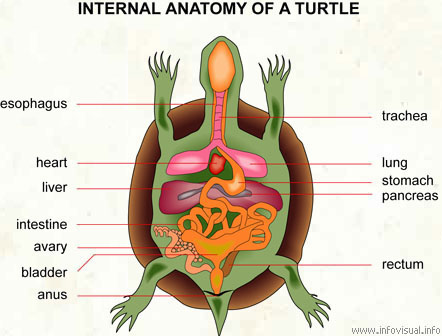Internal anatomy of a turtle

Trachea: the windpipe, which connects the larynx and bronchi of the tortoise.
Lung: respiratory organ of the tortoise.
Stomach: part of the digestive tract of the tortoise between the esophagus and the intestine.
Pancreas: gland in the tortoise that produces digestive enzymes.
Rectum: final part of the tortoise's digestive tract.
Anus: outlet of the tortoise's digestive tract.
Bladder: pocket in which urine collects before it is evacuated.
Ovary: egg-producing reproductive gland.
Intestine: part of the digestive tract of the tortoise after the stomach.
Liver: bile-producing digestive gland.
Heart: blood-pumping organ of the tortoise.
Esophagus: part of the digestive tract of a tortoise between the mouth and the stomach.
Photo :

Turtles are reptiles of the Order Testudines (all living turtles belong to the crown group Chelonia), most of whose body is shielded by a special bony or cartilaginous shell developed from their ribs. The Order Testudines includes both extant (living) and extinct species. The earliest known turtles date from 215 million years ago, making turtles one of the oldest reptile groups and a more ancient group than lizards and snakes. About 300 species are alive today, and some are highly endangered. Turtles cannot breathe in water, but they can hold their breath for various periods of time. Like other reptiles, turtles are poikilothermic or "of varying temperature". Like other amniotes (reptiles, dinosaurs, birds, and mammals), they breathe air and do not lay eggs underwater, although many species live in or around water. The largest turtles are aquatic.
Animation : Turtles vs Sharks
Thanks to YouTube for allowing us to watch this video.